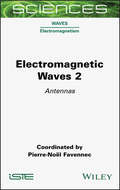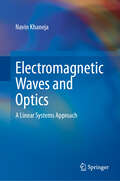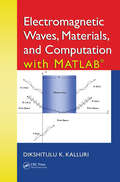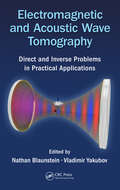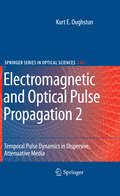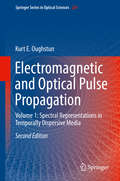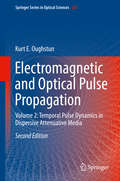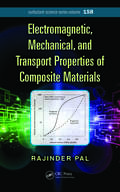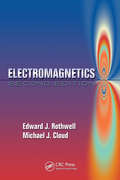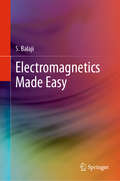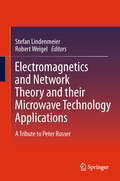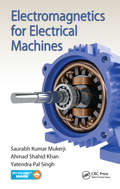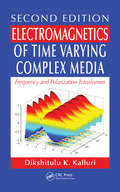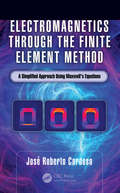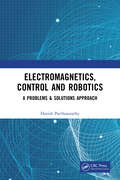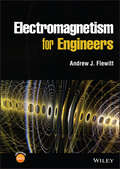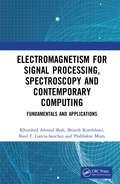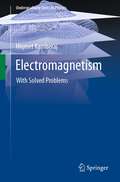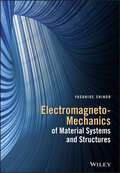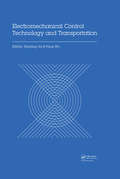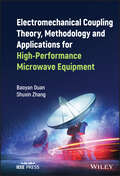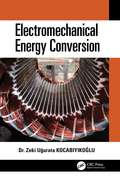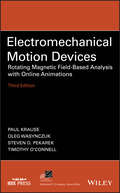- Table View
- List View
Electromagnetic Waves 2: Antennas
by Pierre-Noël FavennecElectromagnetic Waves 2 examines antennas in the field of radio waves. It analyzes the conditions of use and the parameters that are necessary in order to create an effective antenna. This book presents antennas’ definitions, regulations and fundamental equations, and describes the various forms of antennas that can be used in radio: horns, waveguides, coaxial cables, printed and miniature antennas. It presents the characterization methods and the link budgets as well as the digital methods that make the fine calculation of radio antennas possible. Electromagnetic Waves 2 is a collaborative work, completed only with the invaluable contributions of Ibrahima Sakho, Hervé Sizun and JeanPierre Blot, not to mention the editor, Pierre-Noël Favennec. Aimed at students and engineers, this book provides essential theoretical support for the design and deployment of wireless radio and optical communication systems.
Electromagnetic Waves and Optics: A Linear Systems Approach
by Navin KhanejaThe book explores electromagnetic (EM) waves, which are present everywhere—from radio, television, and cell phones to satellite dishes, antennas, and WiFi. The propagation of EM waves is governed by Maxwell's equations. When these waves pass through a medium, they slow down and refract, while in a metallic medium, they are reflected. Metallic boxes and pipes can store and direct EM waves, known as cavities and waveguides. Oscillating currents generate and transmit EM waves through antennas, allowing for long-distance communication after the waves propagate. Since oscillating currents emit EM waves, the author uses coaxial cables and transmission lines to reduce radiation and carry high-frequency currents efficiently. EM waves at very high frequencies in the optical range are responsible for transmitting visual information. The author also discusses lenses and optical instruments like telescopes and microscopes, which are used to magnify optical signals. Additionally, the quantum mechanical origins of a material’s permittivity, which affects the speed of light through the medium, are examined.
Electromagnetic Waves, Materials, and Computation with MATLAB
by Dikshitulu K. KalluriReadily available commercial software enables engineers and students to perform routine calculations and design without necessarily having a sufficient conceptual understanding of the anticipated solution. The software is so user-friendly that it usually produces a beautiful colored visualization of that solution, often camouflaging the fact that t
Electromagnetic and Acoustic Wave Tomography: Direct and Inverse Problems in Practical Applications
by Nathan Blaunstein Vladimir YakubovThis book discusses the development of radio-wave tomography methods as a means of remote non-destructive testing, diagnostics of the internal structure of semi-transparent media, and reconstruction of the shapes of opaque objects based on multi-angle sounding. It describes physical-mathematical models of systems designed to reconstruct images of hidden objects, based on tomographic processing of multi-angle remote measurements of scattered radio and acoustic (ultrasonic) wave radiation.
Electromagnetic and Optical Pulse Propagation 2
by Kurt E. OughstunElectromagnetic & Optical Pulse Propagation presents a detailed, systematic treatment of the time-domain electromagnetics with application to the propagation of transient electromagnetic fields (including ultrawideband signals and ultrashort pulses) in homogeneous, isotropic media which exhibit both temporal frequency dispersion and attenuation. The development is mathematically rigorous with strict adherence to the fundamental physical principle of causality. Approximation methods are based upon mathematically well-defined asymptotic techniques that are based upon the saddle point method. A detailed description is given of the asymptotic expansions used. Meaningful exercises are given throughout the text to help the reader's understanding of the material, making the book a useful graduate level text in electromagnetic wave theory for both physics, electrical engineering and materials science programs. Both students and researchers alike will obtain a better understanding of time domain electromagnetics as it applies to electromagnetic radiation and wave propagation theory with applications to ground and foliage penetrating radar, medical imaging, communications, and the health and safety issues associated with ultrawideband pulsed fields. Volume 2 presents a detailed asymptotic description of plane wave pulse propagation in dielectric, conducting, and semiconducting materials as described by the classical Lorentz model of dielectric resonance, the Rocard-Powles-Debys model of orientational polarization, and the Drude model of metals. The rigorous description of the signal velocity of a pulse in a dispersive material is presented in connection with the question of superluminal pulse propagation.
Electromagnetic and Optical Pulse Propagation: Volume 1: Spectral Representations in Temporally Dispersive Media (Springer Series in Optical Sciences #224)
by Kurt E. OughstunThis volume presents a detailed, rigorous treatment of the fundamental theory of electromagnetic pulse propagation in causally dispersive media that is applicable to dielectric, conducting, and semiconducting media. Asymptotic methods of approximation based upon saddle point methods are presented in detail.
Electromagnetic and Optical Pulse Propagation: Volume 2: Temporal Pulse Dynamics in Dispersive Attenuative Media (Springer Series in Optical Sciences #225)
by Kurt E. OughstunIn two volumes, this book presents a detailed, systematic treatment of electromagnetics with application to the propagation of transient electromagnetic fields (including ultrawideband signals and ultrashort pulses) in dispersive attenuative media. The development in this expanded, updated, and reorganized new edition is mathematically rigorous, progressing from classical theory to the asymptotic description of pulsed wave fields in Debye and Lorentz model dielectrics, Drude model conductors, and composite model semiconductors. It will be of use to researchers as a resource on electromagnetic radiation and wave propagation theory with applications to ground and foliage penetrating radar, medical imaging, communications, and safety issues associated with ultrawideband pulsed fields. With meaningful exercises, and an authoritative selection of topics, it can also be used as a textbook to prepare graduate students for research. Volume 2 presents a detailed asymptotic description of plane wave pulse propagation in dielectric, conducting, and semiconducting materials as described by the classical Lorentz model of dielectric resonance, the Rocard-Powles-Debye model of orientational polarization, and the Drude model of metals. The rigorous description of the signal velocity of a pulse in a dispersive material is presented in connection with the question of superluminal pulse propagation. The second edition contains new material on the effects of spatial dispersion on precursor formation, and pulse transmission into a dispersive half space and into multilayered media. Volume 1 covers spectral representations in temporally dispersive media.
Electromagnetic, Mechanical, and Transport Properties of Composite Materials (Surfactant Science)
by Rajinder PalIn the design, processing, and applications of composite materials, a thorough understanding of the physical properties is required. It is important to be able to predict the variations of these properties with the kind, shape, and concentration of filler materials. The currently available books on composite materials often emphasize mechanical pro
Electromagnetics (Electrical Engineering Textbook Ser.)
by Michael J. Cloud Edward J. Rothwell<p>Providing an ideal transition from introductory to advanced concepts, Electromagnetics, Second Edition builds a foundation that allows electrical engineers to confidently proceed with the development of advanced EM studies, research, and applications. <p>This second edition of a popular text continues to offer coverage that spans the entire field, from electrostatics to the integral solutions of Maxwell’s equations. The book provides a firm grounding in the fundamental concepts of electromagnetics and bolsters understanding through the use of classic examples in shielding, transmission lines, waveguides, propagation through various media, radiation, antennas, and scattering. Mathematical appendices present helpful background information in the areas of Fourier transforms, dyadics, and boundary value problems. The second edition adds a new and extensive chapter on integral equation methods with applications to guided waves, antennas, and scattering. <p>Utilizing the engaging style that made the first edition so appealing, this second edition continues to emphasize the most enduring and research-critical electromagnetic principles.</p>
Electromagnetics Made Easy
by S. BalajiThis book is intended to serve as an undergraduate textbook for a beginner’s course in engineering electromagnetics. The present book provides an easy and simplified understanding of the basic principles of electromagnetics. Abstract theory has been explained using real life examples making it easier for the reader to grasp the complicated concepts. An introductory chapter on vector calculus and the different coordinate systems equips the readers with the prerequisite knowledge to learn electromagnetics. The subsequent chapters can be grouped into four broad sections – electrostatics, magnetostatics, time varying fields, and applications of electromagnetics. Written in lucid terms, the text follows a sequential presentation of the topics, and discusses the relative merits and demerits of each method. Each chapter includes a number of examples which are solved rigorously along with pictorial representations. The book also contains about 400 figures and illustrations which help students visualize the underlying physical concepts. Several end-of-chapter problems are provided to test the key concepts and their applications. Thus the book offers a valuable resource for both students and instructors of electrical, electronics and communications engineering, and can also be useful as a supplementary text for undergraduate physics students.
Electromagnetics and Network Theory and their Microwave Technology Applications
by Robert Weigel Stefan LindenmeierThis volume provides a discussion of the challenges and perspectives of electromagnetics and network theory and their microwave applications in all aspects. It collects the most interesting contribution of the symposium dedicated to Professor Peter Russer held in October 2009 in Munich.
Electromagnetics for Electrical Machines
by Saurabh Kumar Mukerji Ahmad Shahid Khan Yatendra Pal SinghElectromagnetics for Electrical Machines offers a comprehensive yet accessible treatment of the linear theory of electromagnetics and its application to the design of electrical machines. Leveraging valuable classroom insight gained by the authors during their impressive and ongoing teaching careers, this text emphasizes concepts rather than numerical methods, providing presentation/project problems at the end of each chapter to enhance subject knowledge. Highlighting the essence of electromagnetic field (EMF) theory and its correlation with electrical machines, this book: Reviews Maxwell’s equations and scalar and vector potentials Describes the special cases leading to the Laplace, Poisson’s, eddy current, and wave equations Explores the utility of the uniqueness, generalized Poynting, Helmholtz, and approximation theorems Discusses the Schwarz–Christoffel transformation, as well as the determination of airgap permeance Addresses the skin effects in circular conductors and eddy currents in solid and laminated iron cores Contains examples relating to the slot leakage inductance of rotating electrical machines, transformer leakage inductance, and theory of hysteresis machines Presents analyses of EMFs in laminated-rotor induction machines, three-dimensional field analyses for three-phase solid rotor induction machines, and more Electromagnetics for Electrical Machines makes an ideal text for postgraduate-level students of electrical engineering, as well as of physics and electronics and communication engineering. It is also a useful reference for research scholars concerned with problems involving electromagnetics.
Electromagnetics for Electrical Machines
by Saurabh Kumar Mukerji Ahmad Shahid Khan Yatendra Pal SinghElectromagnetics for Electrical Machines offers a comprehensive yet accessible treatment of the linear theory of electromagnetics and its application to the design of electrical machines. Leveraging valuable classroom insight gained by the authors during their impressive and ongoing teaching careers, this text emphasizes concepts rather than numerical methods, providing presentation/project problems at the end of each chapter to enhance subject knowledge. Highlighting the essence of electromagnetic field (EMF) theory and its correlation with electrical machines, this book: Reviews Maxwell’s equations and scalar and vector potentials Describes the special cases leading to the Laplace, Poisson’s, eddy current, and wave equations Explores the utility of the uniqueness, generalized Poynting, Helmholtz, and approximation theorems Discusses the Schwarz–Christoffel transformation, as well as the determination of airgap permeance Addresses the skin effects in circular conductors and eddy currents in solid and laminated iron cores Contains examples relating to the slot leakage inductance of rotating electrical machines, transformer leakage inductance, and theory of hysteresis machines Presents analyses of EMFs in laminated-rotor induction machines, three-dimensional field analyses for three-phase solid rotor induction machines, and more Electromagnetics for Electrical Machines makes an ideal text for postgraduate-level students of electrical engineering, as well as of physics and electronics and communication engineering. It is also a useful reference for research scholars concerned with problems involving electromagnetics.
Electromagnetics of Time Varying Complex Media: Frequency and Polarization Transformer, Second Edition
by Dikshitulu K. KalluriCompletely revised and updated to reflect recent advances in the fields of materials science and electromagnetics, Electromagnetics of Time Varying Complex Media, Second Edition provides a comprehensive examination of current topics of interest in the research community—including theory, numerical simulation, application, and experimental work. Written by a world leader in the research of frequency transformation in a time-varying magnetoplasma medium, the new edition of this bestselling reference discusses how to apply a time-varying medium to design a frequency and polarization transformer. This authoritative resource remains the only electromagnetic book to cover time-varying anisotropic media, Frequency and Polarization Transformer based on a switched magnetoplasma medium in a cavity, and FDTD numerical simulation for time-varying complex medium. Providing a primer on the theory of using magnetoplasmas for the coherent generation of tunable radiation, early chapters use a mathematical model with one kind of complexity—eliminating the need for high-level mathematics. Using plasma as the basic medium to illustrate various aspects of the transformation of an electromagnetic wave by a complex medium, the text highlights the major effects of each kind of complexity in the medium properties. This significantly expanded edition includes: Three new parts: (a) Numerical Simulation: FDTD Solution, (b) Application: Frequency and Polarization Transformer, and (c) Experiments A slightly enhanced version of the entire first edition, plus 70% new material Reprints of papers previously published by the author—providing researchers with complete access to the subject The text provides the understanding of research techniques useful in electro-optics, plasma science and engineering, microwave engineering, and solid state devices. This complete resource supplies an accessible treatment of the effect of time-varying parameters in conjunction with one or more additional kinds of complexities in the properties of particular mediums.
Electromagnetics through the Finite Element Method: A Simplified Approach Using Maxwell's Equations
by José Roberto CardosoShelving Guide: Electrical Engineering Since the 1980s more than 100 books on the finite element method have been published, making this numerical method the most popular. The features of the finite element method gained worldwide popularity due to its flexibility for simulating not only any kind of physical phenomenon described by a set of differential equations, but also for the possibility of simulating non-linearity and time-dependent studies. Although a number of high-quality books cover all subjects in engineering problems, none of them seem to make this method simpler and easier to understand. This book was written with the goal of simplifying the mathematics of the finite element method for electromagnetic students and professionals relying on the finite element method for solving design problems. Filling a gap in existing literature that often uses complex mathematical formulas, Electromagnetics through the Finite Element Method presents a new mathematical approach based on only direct integration of Maxwell’s equation. This book makes an original, scholarly contribution to our current understanding of this important numerical method.
Electromagnetics, Control and Robotics: A Problems & Solutions Approach
by Harish ParthasarathyThis book covers a variety of problems, and offers solutions to some, in:• Statistical state and parameter estimation in nonlinear stochastic dynamical system in both the classical and quantum scenarios.• Propagation of electromagnetic waves in a plasma as described by the Boltzmann Kinetic Transport Equation.• Classical and Quantum General Relativity. It will be of use to Engineering undergraduate students interested in analysing the motion of robots subject to random perturbation, and also to research scientists working in Quantum Filtering.
Electromagnetism for Engineers
by Andrew J. FlewittElectromagnetism for Engineers An easily accessible textbook to introduce the power of electromagnetism Electromagnetism can be a difficult subject to grasp and to teach. Much of what we take for granted in modern life is enabled by electromagnetic effects, but it isn’t always easy to understand the impact of electromagnetism compared to other areas of engineering, such as mechanics, which are more tangibly observed and felt. Although electromagnetism is a crucial and important branch of physics with elegant mathematics, many students can find the study of electromagnetism inaccessible. It is crucial for students of electrical and electronic engineering and physics to have a strong understanding of electromagnetism and how it impacts communications, power generation and transmission, semiconductor devices, motors, and more. Electromagnetism for Engineers aims to develop a student’s understanding of electromagnetism in the context of real effects and how they apply to such applications, whilst maintaining the sophistication of the mathematics that can be used to give deeper insight. It begins by describing the fundamentals of electromagnetism before a more detailed discussion of the basic concepts developed for specific application areas. It then considers the application of electromagnetism to transmission lines, antennas, and waveguides. Electromagnetism for Engineers readers will find: A unique approach that illustrates the link between real-life applications and fundamental theory of electromagnetism Clear, concise language to help students gain a full understanding of the subject Carefully designed figures to illustrate points throughout the book Accompanying website at www.wiley.com/go/flewitt1418 Electromagnetism for Engineers has been written as a textbook for undergraduates studying electronic or electrical engineering. The manual can also be of interest to physics students and??to graduate-level students desirous of having a general book on electromagnetism. It is also a useful reference for professional engineers looking for a refresher on the fundamentals of electromagnetism.
Electromagnetism for Signal Processing, Spectroscopy and Contemporary Computing: Fundamentals and Applications
by Prabhakar Misra Brijesh Kumbhani Khurshed Ahmad Shah Raul F. Garcia-SanchezThis comprehensive textbook will help readers to acquire a thorough understanding of the fundamentals of electromagnetism and its applications in various areas including spectroscopy, signal processing and contemporary computation. The text introduces the principals and applications of electricity, magnetism and electromagnetic theory which is foundation for communication systems, spectroscopy, and modern computing. It is followed by discussing the digital systems and their importance in computing, difference between digital signal transmission and wireless media, visualization techniques and useful simulation and computational techniques, besides advances in quantum computing. Aimed at senior undergraduate and graduate students in the field of electrical engineering, electronics and communication engineering, this textbook: Provides fundamentals of electromagnetism and its applications in a single volume. Covers recent developments in computing and artificial intelligence. Discussion digital signal processing and wireless communication in depth. Covers advanced applications of electromagnetism in communication, spectroscopy, and computing. Discusses Computer Modelling & Simulation, Artificial Intelligence, and Quantum Computing.
Electromagnetism: With Solved Problems (Undergraduate Texts in Physics)
by Hiqmet KamberajAny curriculum involving science and/or engineering will eventually find itself entering the realm of physics. This book seeks to introduce students to a number of the fundamental concepts in physics and illustrate how different theories were developed out of physical observations and phenomena. The book presents multi-chapter sections on electrostatics, magnetism and electromagnetic waves, with eyes on both the past and the future, touching, along the way, on Coulomb, Gauss, Maxwell, Ohm, Biot-Savart, Ampere, Faraday, Fresnel and Lorentz. The book also contains an appendix that provides the reader with a portion of the mathematical background of vector analysis and vector differential operators. The book approaches its topics through a focus on examples and problem-solving techniques, illustrating vividly how physical theories are applied to problems in engineering and science. The book is primarily aimed at undergraduate students in these two fields, but it also features chapters that are geared towards senior undergraduates working on their final year theses.
Electromagneto-Mechanics of Material Systems and Structures
by Yasuhide ShindoComprehensive introduction to the fundamentals and state of the art research developments in electromagneto-mechanics of adaptive materials• Covers a wide and varied range of subject areas (theoretical, experimental, computational studies and/or industrial applications) of electromagneto-mechanics from state-of-the-art fundamental research to applied research, and applications in emerging technologies• Electromagneto-mechanics of material systems and structures has developed rapidly with extensive applications in electronics industry, nuclear engineering, smart materials and MEMS• Written by one of the world’s leading experts in this field
Electromechanical Control Technology and Transportation: Proceedings of the 2nd International Conference on Electromechanical Control Technology and Transportation (ICECTT 2017), January 14-15, 2017, Zhuhai, China
by Feng Wu Xiaoling JiaThe 2017 2nd International Conference on Electromechanical Control Technology and Transportation (ICECTT 2017) was held on January 14–15, 2017 in Zhuhai, China. ICECTT 2017 brought together academics and industrial experts in the field of electromechanical control technology and transportation to a common forum. The primary goal of the conference was to promote research and developmental activities in electromechanical control technology and transportation. Another goal was to promote exchange of scientific information between researchers, developers, engineers, students, and practitioners working all around the world. The conference will be held every year thus making it an ideal platform for people to share views and experiences in electromechanical control technology and transportation and related areas.
Electromechanical Coupling Theory, Methodology and Applications for High-Performance Microwave Equipment
by Baoyan Duan Shuxin ZhangElectromechanical Coupling Theory, Methodology and Applications for High-Performance Microwave Equipment Electromechanical Coupling Theory, Methodology, and Applications for High-Performance Microwave Equipment is an authoritative and up-to-date guide to the structural, mechanical, and electrical aspects of electromechanical coupling. Addressing control, electromagnetism, and structural engineering, this comprehensive reference covers the electromechanical coupling of high-performance microwave electronic equipment (MEE), such as antennas, radar, large radio telescopes, and telecommunication and navigation equipment. The book is divided into four main sections, beginning with an introduction to electromechanical coupling (EMC) theory and a detailed description of the multi-field coupling model (MFCM) and the influence mechanism (IM) of nonlinear factors of antenna-servo-feeder systems on performance. Subsequent sections discuss MFCM- and IM-based design methodology, EMC-based measurement and testing, computer software for coupling analysis and design of electronic equipment, and various engineering applications of EMC theory and the IM of typical electronic equipment. In addition, the book: Discusses information and data transfer in electromagnetic fields, mechanical and structural deformation fields, and temperature fields Explains how high-performance microwave electronic equipment differs from traditional mechanical equipment Addresses EMC-based and general design-vector based optimization of electronic equipment design Describes applications such as a gun-guided radar system for warships and a large-diameter antenna for moon exploration Includes evaluation criteria to validate MFCM/IM design theory and methodology Electromechanical Coupling Theory, Methodology, and Applications for High-Performance Microwave Equipment is essential reading for circuit designers, microwave engineers, researchers working with high-frequency microwave engineering, and engineers working with integrated circuits in radar, communications, IoT, antenna engineering, and remote sensing.
Electromechanical Energy Conversion
by Zeki Uğurata KocabiyikoğluThis book is intended to be a textbook for undergraduate students studying electrical and electronic engineering in universities and colleges. Therefore, the level and amount of the knowledge to be transferred to the reader is kept to as much as what can be taught in one academic semester of a university or a college course. Although the subject is rather classical and somehow well established in some respects, it is vast and can be difficult to grasp if unnecessary details are not avoided. This book is aimed to give the reader just what is necessary - with plenty of short and easily understandable examples and drawings, figures, and tables. A course on electromechanical energy conversion is a necessity in all universities and colleges entitled to grant a license for electrical engineering. This book is aimed at meeting the requirements of this essential subject by providing necessary information to complete the course. A compact chapter is included with figures and tables on energy and the restraints on its production brought about by global climate change. A new approach has been tried for some of the classic subjects including magnetic circuits and electrical machines together with today’s much-used motors.
Electromechanical Motion Devices: Rotating Magnetic Field-Based Analysis with Online Animations (IEEE Press Series on Power Engineering #90)
by Oleg Wasynczuk Steven Pekarek Paul Krause Timothy O'ConnellThe updated third edition of the classic book that provides an introduction to electric machines and their emerging applications The thoroughly revised and updated third edition of Electromechanical Motion Devices contains an introduction to modern electromechanical devices and offers an understanding of the uses of electric machines in emerging applications such as in hybrid and electric vehicles. The authors—noted experts on the topic—put the focus on modern electric drive applications. The book includes basic theory, illustrative examples, and contains helpful practice problems designed to enhance comprehension. The text offers information on Tesla's rotating magnetic field, which is the foundation of reference frame theory and explores in detail the reference frame theory. The authors also review permanent-magnet ac, synchronous, and induction machines. In each chapter, the material is arranged so that if steady-state operation is the main concern, the reference frame derivation can be de-emphasized and focus placed on the steady state equations that are similar in form for all machines. This important new edition: • Features an expanded section on Power Electronics • Covers Tesla's rotating magnetic field • Contains information on the emerging applications of electric machines, and especially, modern electric drive applications • Includes online animations and a solutions manual for instructors Written for electrical engineering students and engineers working in the utility or automotive industry, Electromechanical Motion Devices offers an invaluable book for students and professionals interested in modern machine theory and applications.
Electromechanical Motion Systems
by Frederick G. MoritzAn introductory reference covering the devices, simulations and limitations in the control of servo systemsLinking theoretical material with real-world applications, this book provides a valuable introduction to motion system design. The book begins with an overview of classic theory, its advantages and limitations, before showing how classic limitations can be overcome with complete system simulation. The ability to efficiently vary system parameters (such as inertia, friction, dead-band, damping), and quickly determine their effect on performance, stability, efficiency, is also described. The author presents a detailed review of major component characteristics and limitations as they relate to system design and simulation.The use of computer simulation throughout the book will familiarize the reader as to how this contributes to efficient system design, how it avoids potential design flaws and saves both time and expense throughout the design process. The comprehensive coverage of topics makes the book ideal for professionals who need to apply theory to real-world situations, as well as students who wish to enhance their understanding of the topic. * Covers both theory and practical information at an introductory level, allowing readers to advance to further topics having obtained a strong grounding in the subject* Provides a connection between classic servo technology and the evolution of computer control and simulation* VisSim demonstration material available on an accompanying website enabling readers to experiment with system examples
